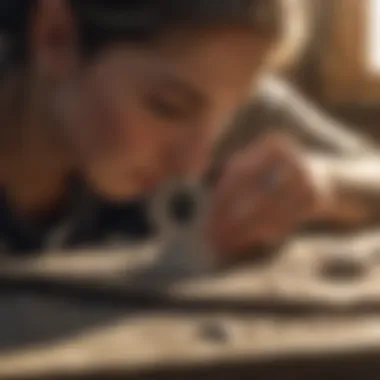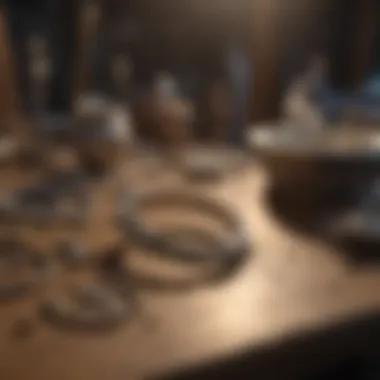Discover the Best Beginner Silversmithing Classes Near Me


The world of beginner silversmithing classes awaits, offering individuals the opportunity to hone their craft in crafting intricate silver jewelry pieces. This comprehensive guide is here to assist you in finding and selecting the ideal course to kickstart your silversmithing passion.
Rock and Fossil Identification
Silver, like rocks and fossils, undergoes a transformation process from raw materials to refined creations. While the types of rocks and fossils differ in composition, silversmithing involves understanding the characteristics of silver and how to work with it intricately with specialized tools.
Collecting Tips and Techniques
In silversmithing, collecting tips matter – from sourcing the finest silver materials to honing one's craftsmanship through dedication and practice. Locating prime materials for silversmithing is akin to discovering prime collecting sites for rocks and fossils; both require precision and attention to detail.
Preservation and Display
Preservation techniques in silversmithing are as crucial as preserving rocks and fossils, ensuring the longevity and quality of crafted pieces. Proper storage methods secure the value of silver creations, much like how rocks and fossils are stored to maintain their authenticity and integrity.
Geological Insights
Understanding the geological aspects of silver formation provides valuable insights into the history and significance of this precious metal. Just as rocks and fossils reveal the Earth's geological processes and historical narratives, silver unveils its own tale of notable discoveries and scientific importance.
Understanding Silversmithing Classes
In the intricate world of silversmithing, understanding the essence of silversmithing classes plays a pivotal role in mastering the craft. These classes serve as the foundation where beginners hone their skills and learn the art of crafting ornate silver jewelry pieces. By immersing oneself in a structured learning environment, individuals can explore the rich history and techniques of silversmithing, unlocking a world of creativity and expression. Through this article, we will delve into the key elements, benefits, and considerations surrounding understanding silversmithing classes,
Introduction to Silversmithing
History and Significance of Silversmithing
Delving into the history and significance of silversmithing provides a profound insight into the evolution of this timeless craft. From ancient civilizations to modern-day artists, the art of silversmithing has held a significant place in human culture. Understanding the historical context behind silversmithing not only enriches one's knowledge but also fosters a deep appreciation for the craftsmanship involved. By delving into the historical origins and cultural importance of silversmithing, beginners can grasp the heritage that encapsulates this art form, inspiring them on their own silversmithing journey.
Basic Techniques in Silversmithing
Mastering the basic techniques in silversmithing is essential for individuals embarking on this creative path. Techniques such as forging, soldering, and stone setting form the building blocks of silversmithing craftsmanship. By honing these fundamental skills, aspiring silversmiths can create intricate designs and personalized jewelry pieces. Learning the basics not only establishes a strong foundation but also allows for experimentation and innovation in silversmithing. Embracing these techniques equips beginners with the tools necessary to bring their creative visions to life, making them indispensable in the world of silversmithing,
Benefits of Enrolling in Silversmithing Classes
Hands-On Learning Experience
The hands-on learning experience offered by silversmithing classes immerses students in a practical and interactive environment. By working directly with silver and tools, individuals can develop a tactile understanding of the craft, enhancing their skills and techniques. This experiential approach not only accelerates learning but also instills a sense of confidence and mastery in students as they witness their creations take form. The hands-on experience also fosters a deeper connection to the craft, igniting a passion for silversmithing that goes beyond theory,
Opportunity for Creative Expression
Enrolling in silversmithing classes opens up a world of creative possibilities for individuals seeking to express themselves artistically. The freedom to design and create unique jewelry pieces allows students to channel their creativity and imagination into tangible works of art. Whether designing a simple silver ring or a complex pendant, the opportunity for creative expression in silversmithing classes is boundless. This outlet for self-expression not only nurtures artistic development but also serves as a platform for personal growth and exploration,


Finding Local Classes
Crafting Communities and Workshops
Joining crafting communities and workshops provides a supportive and collaborative environment for individuals interested in silversmithing. These communal spaces not only offer access to shared tools and resources but also foster a sense of camaraderie among like-minded individuals. Engaging with fellow craftsmen and receiving feedback in a communal setting can significantly enhance the learning experience and inspire creativity. Crafting communities and workshops serve as hubs of creativity and innovation, propelling aspiring silversmiths towards excellence in their craft,
Jewelry Schools and Studios Nearby
Jewelry schools and studios in close proximity offer structured learning experiences for individuals looking to delve deeper into the art of silversmithing. These professional settings provide access to specialized equipment, expert guidance, and a curriculum tailored to nurture silversmithing skills. By enrolling in local schools and studios, students can benefit from a focused and comprehensive education that covers a wide range of techniques and design concepts. Additionally, the proximity of these institutions ensures convenience and facilitates regular practice and skill development. Embracing the professional setting of jewelry schools and studios nearby can accelerate one's growth and proficiency in silversmithing,
Factors to Consider When Choosing a Class
When delving into the realm of beginner silversmithing classes, the importance of considering various factors before choosing the right one becomes paramount. Selecting a silversmithing class is a pivotal decision that can significantly impact your learning experience and future in the field. By carefully evaluating several crucial aspects, you can ensure that you make the most out of your silversmithing journey. Factors like instructor expertise, class curriculum, duration, cost, materials, reviews, and testimonials play a pivotal role in shaping your silversmithing education and progression.
Instructor Expertise and Teaching Style
Qualifications and Experience
Every aspiring silversmith should prioritize evaluating the qualifications and experience of potential instructors. An instructor with extensive experience in the art of silversmithing can offer invaluable insights, tips, and guidance to help you grasp the intricacies of the craft more effectively. Look for instructors who have a robust background in working with silver, mastering various techniques, and creating intricate jewelry pieces. Their expertise can serve as a foundation for your own learning journey, providing you with the necessary skills to progress seamlessly.
Approach to Teaching the Art of Silversmithing
The approach to teaching employed by instructors can significantly influence your learning experience. A hands-on, practical approach that emphasizes interactive demonstrations and personalized feedback can enhance your understanding and execution of silversmithing techniques. Seek instructors who are passionate about fostering creativity and experimentation while nurturing a supportive learning environment. An instructor's teaching style should align with your learning preferences and goals, ensuring a harmonious and fruitful educational experience.
Class Curriculum and Duration
Topics Covered in the Course
The breadth and depth of topics covered in a silversmithing course can give you an insight into the skills and knowledge you will acquire. A comprehensive curriculum that includes fundamental techniques, advanced practices, design principles, and creative exploration can broaden your silversmithing repertoire. Look for courses that offer a well-rounded curriculum tailored to cater to beginners while also challenging and inspiring growth.
Length of the Program
The duration of a silversmithing program is another essential factor to consider when choosing a class. Longer programs may provide more in-depth learning opportunities, allowing you to refine your skills and undertake complex projects. However, shorter courses can be more suitable for individuals seeking a brief introduction to silversmithing or concentrating on specific skill enhancement. Consider your availability, learning pace, and desired level of proficiency when selecting a program that aligns with your needs and schedule.
Cost and Materials
Tuition Fees and Additional Expenses
Understanding the cost structure of a silversmithing class is crucial for managing your educational investment effectively. Consider the tuition fees, registration costs, and any additional expenses associated with materials, tools, or equipment. While quality education often comes at a price, evaluate the value proposition of the course in relation to its cost. Ensure transparent pricing and clear breakdown of expenses to make an informed decision that balances affordability with educational benefits.
Supplies and Tools Provided
The availability of supplies and tools within a silversmithing class can alleviate the burden of sourcing materials independently. Evaluate whether the course includes essential tools, materials, and equipment necessary for practical sessions and projects. Access to high-quality supplies can enhance your learning experience, enabling you to focus on honing your skills and creativity without logistical challenges. Courses that provide a comprehensive set of tools can streamline your learning process and facilitate seamless hands-on practice.


Reviews and Testimonials
Feedback from Previous Students
Gauging the feedback and testimonials from former students can offer valuable insights into the quality and effectiveness of a silversmithing class. Positive testimonials highlighting engaging lessons, helpful feedback, and skill improvement indicate a conducive learning environment. Seek out reviews that align with your learning objectives and expectations, ensuring that the class meets your educational standards and aspirations.
Reputation of the Class
Analyze the reputation and standing of the silversmithing class within the crafting community and industry. A class with a strong reputation for excellence, innovation, and student success is more likely to deliver a rewarding learning experience. Consider factors such as instructor credibility, course outcomes, alumni achievements, and industry recognition to gauge the class's reputation accurately. Opting for a reputable class can enhance your credibility as a silversmith and open doors to networking opportunities and artistic collaborations.
Preparing for Your First Class
Being well-prepared for your first silversmithing class is crucial for setting a strong foundation in this intricate craft. Preparation involves gathering the necessary tools, setting up your workspace, and cultivating the right mindset. By focusing on these aspects, you can maximize your learning experience and creativity in silversmithing.
Gathering Necessary Tools
Essential Silversmithing Tools
When delving into silversmithing, having the right tools is essential for achieving precision and craftsmanship in your work. Essential tools include a jeweler's saw, bench pin, hammer, files, pliers, and soldering equipment. These tools contribute significantly to the overall success of your projects by enabling you to shape, refine, and join metals effectively. Their durability and functionality make them popular choices among silversmithing enthusiasts. The unique feature of essential silversmithing tools lies in their ability to withstand frequent use and provide consistent results, making them invaluable assets in creating high-quality silver jewelry pieces.
Recommended Suppliers
Selecting reputable suppliers for your silversmithing materials is vital for obtaining high-quality resources that enhance your work. Recommended suppliers offer a wide range of metals, gemstones, and tools, ensuring you have access to top-notch materials for your projects. The key characteristic of these suppliers is their commitment to providing premium products that meet the standards of professional silversmiths. Additionally, their diverse inventory and reliable shipping services make them a preferred choice for sourcing materials conveniently. The unique feature of recommended suppliers is their ability to offer a one-stop shop for all your silversmithing needs, simplifying the procurement process and saving you time and effort.
Setting Up Your Workspace
Creating a Functional Work Area
Establishing a functional work area is essential for promoting efficiency and organization in your silversmithing endeavors. A well-designed workspace should have adequate lighting, ventilation, and ergonomic furniture to ensure comfort and safety during crafting sessions. By creating an ergonomic layout, you can optimize your workflow and minimize distractions, allowing you to focus on honing your silversmithing skills. The key characteristic of a functional work area is its ability to enhance productivity and creativity by providing a conducive environment for experimentation and innovation. Its unique feature lies in its adaptability to various project requirements, allowing you to customize the space according to your specific needs.
Organizing Materials and Equipment
Proper organization of materials and equipment is essential for maintaining a structured and efficient work environment. By categorizing and storing tools and supplies systematically, you can streamline your creative process and prevent clutter that may hinder your workflow. Organizing materials and equipment enables quick access to essential items, eliminating time wasted on searching for tools during projects. The key characteristic of organized materials and equipment is their contribution to a seamless silversmithing experience, allowing you to work with precision and focus. Their unique feature lies in their ability to enhance workflow fluidity and creativity by providing a well-maintained workspace that inspires productivity.
Mindset and Expectations
Persistence and Patience
Developing a mindset of persistence and patience is vital for success in silversmithing, as mastering this craft requires dedication and resilience. Persisting through challenges and setbacks allows you to refine your skills and techniques, leading to continuous improvement in your work. Patience is instrumental in silversmithing, as intricate designs and intricate details often require meticulous attention and precision. The key characteristic of persistence and patience is their role in fostering perseverance and growth in silversmithing, enabling you to push beyond your limits and explore new possibilities in jewelry making. Their unique feature lies in their capacity to instill discipline and determination, ensuring a fulfilling and rewarding silversmithing journey.
Goals for Your Silversmithing Journey
Establishing clear goals for your silversmithing journey is essential for setting a direction and purpose in your craft. By defining achievable objectives, you can track your progress and celebrate milestones along the way. Setting specific goals, whether mastering a particular technique or executing a complex design, provides motivation and focus in your silversmithing endeavors. The key characteristic of goals for your silversmithing journey is their ability to inspire creativity and drive, propelling you towards continuous learning and innovation in jewelry making. Their unique feature lies in their adaptability to your evolving skills and interests, guiding you towards fulfilling your potential as a silversmith.


Embracing the Art of Silversmithing
In the realm of silversmithing, embracing the art is not just about creating beautiful pieces but also about immersing oneself in a rich tradition of craftsmanship and creativity. For beginners eager to explore this world, understanding and embodying the essence of silversmithing can be a transformative journey. Embracing the art involves not only learning techniques but also delving into the history and significance of this timeless craft.
When it comes to connecting with the art of silversmithing, beginners can expect to explore a spectrum of techniques and designs. From traditional methodologies that pay homage to age-old practices to modern and contemporary styles that push the boundaries of innovation, there is a wealth of knowledge waiting to be uncovered.
Exploring Techniques and Designs
Traditional Silversmithing Methods
Traditional silversmithing methods form the backbone of the craft, rooted in centuries-old traditions passed down through generations. The meticulous attention to detail and focus on handcrafted precision are key characteristics of traditional silversmithing, ensuring that each piece carries a sense of heritage and craftsmanship. While traditional methods may require more time and skill, they offer a unique authenticity and connection to the art that is unparalleled. Embracing traditional silversmithing methods allows beginners to appreciate the intricate artistry and timeless quality of handmade silver jewelry.
Modern and Contemporary Styles
In contrast, modern and contemporary styles in silversmithing bring a fresh perspective to the craft, incorporating innovative techniques and cutting-edge designs. The key characteristic of modern silversmithing lies in its fusion of traditional craftsmanship with avant-garde aesthetics, resulting in pieces that are both unique and stylish. Embracing modern and contemporary styles opens up a world of possibilities for beginners, encouraging experimentation and bold creativity. While these styles may offer a more unconventional approach, they provide an avenue for self-expression and artistic exploration in silversmithing.
Creating Your First Masterpiece
Guided Projects in Class
For beginners embarking on their silversmithing journey, guided projects in class serve as stepping stones towards mastering essential techniques and honing craftsmanship skills. These projects are designed to provide structured guidance and hands-on experience, allowing students to apply learned skills in a supportive environment. The key characteristic of guided projects is their ability to instill confidence and competence in beginners, building a strong foundation for future creative endeavors. While the structure of guided projects may limit complete creative freedom, it offers a structured approach to learning and helps students develop fundamental skills.
Personalized Jewelry Design
Personalized jewelry design allows beginners to infuse their unique style and creativity into their silversmithing projects. The key characteristic of personalized design is its focus on individual expression and customization, enabling students to create pieces that reflect their personal taste and aesthetic preferences. Embracing personalized jewelry design empowers beginners to explore their creativity and experiment with different techniques, leading to the creation of truly one-of-a-kind works. While personalized design offers creative freedom, it also requires careful planning and attention to detail to achieve desired results.
Connecting with Fellow Silversmiths
Building a Network within the Silversmithing Community
Building a network within the silversmithing community is essential for beginners seeking guidance, inspiration, and collaboration. The key characteristic of community building is the opportunity to connect with like-minded individuals who share a passion for silversmithing, creating a supportive ecosystem for learning and growth. By networking within the community, beginners can exchange ideas, seek advice, and celebrate successes together. While building a network enhances learning opportunities and fosters camaraderie, it also requires active participation and engagement to nurture meaningful connections.
Sharing Tips and Inspiration
Sharing tips and inspiration within the silversmithing community fosters a culture of learning and creativity among beginners. The key characteristic of sharing is the mutual exchange of knowledge, techniques, and ideas that enrich the silversmithing experience for all involved. By sharing tips and inspiration, beginners can learn new skills, gain insights into different approaches, and spark new ideas for their projects. While sharing promotes a sense of community and collaboration, it also requires openness and willingness to contribute to the collective growth of fellow silversmiths.
Conclusion
Diving into the world of beginner silversmithing classes offers a transformative journey for individuals eager to hone their craft and create exquisite silver jewelry pieces from scratch. The meticulous process of choosing the right class plays a crucial role in shaping one's silversmithing experience. Understanding the relevance of enrolling in a suitable program not only enhances skill development but also fosters a deep sense of creative fulfillment. By carefully considering key elements such as instructor expertise, class curriculum, costs, and peer reviews, participants can make informed decisions that align with their learning objectives and artistic aspirations. Ultimately, the conclusion segment of this article encapsulates the essence of embarking on a silversmithing journey, providing a roadmap for aspiring artisans to navigate the vast landscape of silversmithing education.
Embarking on Your Silversmithing Journey
Choosing the Right Class for You
Selecting the right silversmithing class is a pivotal step in starting your creative journey in jewelry making. The process of choosing the perfect class involves evaluating various factors such as instructor expertise, teaching style, class curriculum, and alignment with personal goals. By opting for a course that resonates with your learning preferences and artistic vision, you can lay a solid foundation for exploring the art of silversmithing. The key characteristic of choosing the right class lies in finding a balance between technical instruction and artistic freedom, allowing students to develop their skills while expressing their unique creative voice. This tailored approach ensures a fulfilling and enriching learning experience tailored to individual needs, setting the stage for a successful silversmithing venture.
Unleashing Your Creativity in Silversmithing
Unleashing creativity in silversmithing opens doors to boundless possibilities of self-expression and craftsmanship. This aspect plays a vital role in cultivating a distinct artistic identity and pushing boundaries in traditional and contemporary silversmithing styles. By encouraging experimentation and innovation, individuals can breathe life into their designs, forging visually captivating and emotionally resonant jewelry pieces. The unique feature of unleashing creativity lies in its ability to nurture artistic growth and ignite passion for the craft, empowering silversmiths to explore unconventional techniques and refine their signature aesthetic. While the journey of creative exploration may present challenges and setbacks, the rewards of self-discovery and artistic fulfillment far outweigh any initial hurdles, making it a worthwhile pursuit in the realm of silversmithing.







